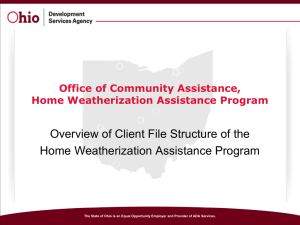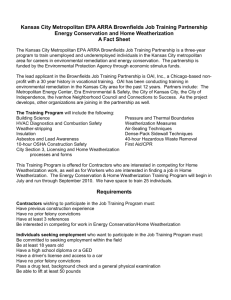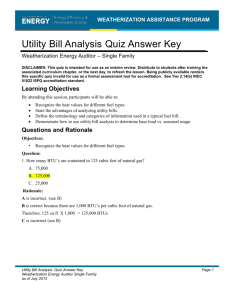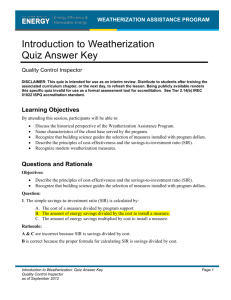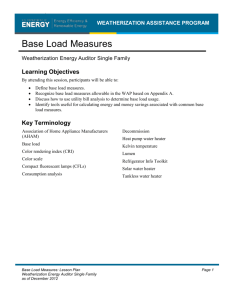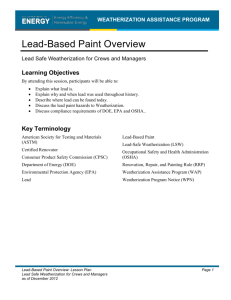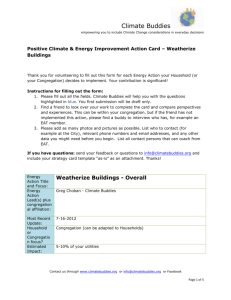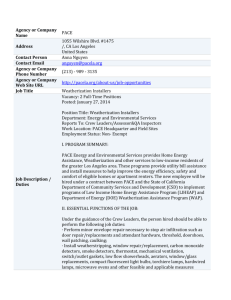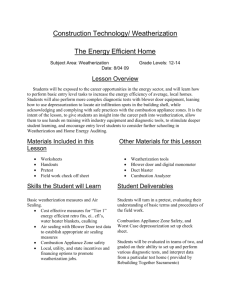Weatherization Information
advertisement
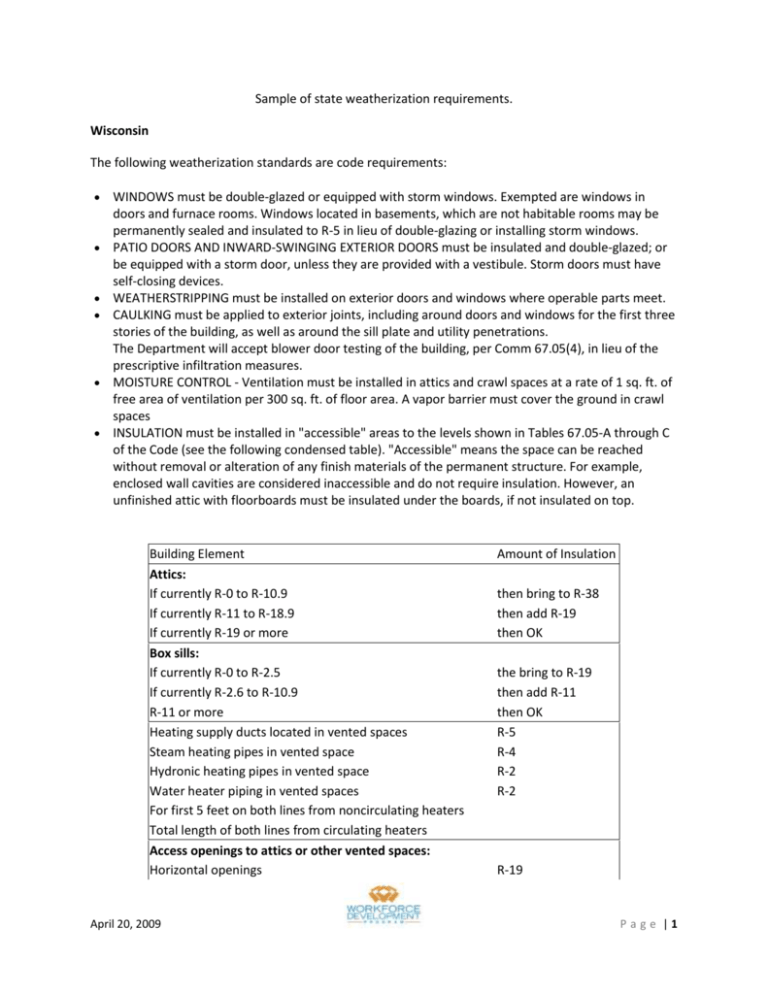
Sample of state weatherization requirements. Wisconsin The following weatherization standards are code requirements: WINDOWS must be double-glazed or equipped with storm windows. Exempted are windows in doors and furnace rooms. Windows located in basements, which are not habitable rooms may be permanently sealed and insulated to R-5 in lieu of double-glazing or installing storm windows. PATIO DOORS AND INWARD-SWINGING EXTERIOR DOORS must be insulated and double-glazed; or be equipped with a storm door, unless they are provided with a vestibule. Storm doors must have self-closing devices. WEATHERSTRIPPING must be installed on exterior doors and windows where operable parts meet. CAULKING must be applied to exterior joints, including around doors and windows for the first three stories of the building, as well as around the sill plate and utility penetrations. The Department will accept blower door testing of the building, per Comm 67.05(4), in lieu of the prescriptive infiltration measures. MOISTURE CONTROL - Ventilation must be installed in attics and crawl spaces at a rate of 1 sq. ft. of free area of ventilation per 300 sq. ft. of floor area. A vapor barrier must cover the ground in crawl spaces INSULATION must be installed in "accessible" areas to the levels shown in Tables 67.05-A through C of the Code (see the following condensed table). "Accessible" means the space can be reached without removal or alteration of any finish materials of the permanent structure. For example, enclosed wall cavities are considered inaccessible and do not require insulation. However, an unfinished attic with floorboards must be insulated under the boards, if not insulated on top. Building Element Attics: If currently R-0 to R-10.9 If currently R-11 to R-18.9 If currently R-19 or more Box sills: If currently R-0 to R-2.5 If currently R-2.6 to R-10.9 R-11 or more Heating supply ducts located in vented spaces Steam heating pipes in vented space Hydronic heating pipes in vented space Water heater piping in vented spaces For first 5 feet on both lines from noncirculating heaters Total length of both lines from circulating heaters Access openings to attics or other vented spaces: Horizontal openings April 20, 2009 Amount of Insulation then bring to R-38 then add R-19 then OK the bring to R-19 then add R-11 then OK R-5 R-4 R-2 R-2 R-19 P a g e |1 Vertical openings Average "R" Values For One Inch of Insulation: Blown Fiberglass or mineral wool Blankets or batts (fiberglass or mineral wool) Cellulose (paper pulp) Molded polystyrene ("beadboard") Extruded polystyrene (smooth-skinned) Vermiculite Polyisocyanurate April 20, 2009 R-5 R-2.9 R-3.1 R-3.4 R-3.6 R-5.0 R-2.3 R-7.2 P a g e |2 Sample Classes offered by a Weatherization Assistance Program Technical Assistance Center (WAPTAC) COAD Ohio Weatherization Training Center Course Overview Required Code Books NFPA 54-2006 edition, NFPA 211-2006 edition, NFPA 31-2006 edition, NFPA 58-2008 edition, NFPA 70 and the NEC 2008 edition BLOWER DOOR USE (BDU): This 2-day class is designed to instruct field personnel in the basic use of our most valuable tool, the Minneapolis Model 3 Blower door. Students will spend time in the classroom learning and discussing the use of the blower door and then spend time infield implementing the knowledge they have gained. NO PREREQUISITES CODES AND STANDARDS (COST): This course is intended to be an introduction to the OWPS, and the three most frequently utilized NFPA code books (54, 31, and 211). It is designed for personnel that either are Inspectors or are going through the Inspection Series. NO PREREQUISITES COMBUSTION ANALYSIS FOR CONTRACTORS (COMB): A three-day class designed to provide the heating contractor with the necessary information to perform all residential heating system work per the Ohio Weatherization Standards (OWPS). Classroom discussions will include review of relevant OWPS sections, the national codes, new furnace installation practices, furnace maintenance and repair requirements, combustion testing and health and safety issues. NO PREREQUISITES COMBUSTION ANALYSIS FOR CONTRACTORS CERTIFICATION (CERT: A three-day class designed to provide the heating contractor with the necessary information to perform all residential heating system work per the Ohio Weatherization Standards (OWPS). Classroom discussions will include review of relevant OWPS sections, the national codes, new furnace installation practices, furnace maintenance and repair requirements, combustion testing and health and safety issues. A written exam and infield testing for skills and knowledge are combined to determine HWAP certification. NO PREREQUISITES CONSUMER ENERGY EDUCATION (CEE): The two-day Consumer Energy Education class is designed to enhance communication techniques with a wide variety of consumers. This class will train the students how to educate and involve the people living in the home to participate within the energy efficiency process. NO PREREQUISITES April 20, 2009 P a g e |3 DUCT TESTING AND SEALING (DTS): This 2-day class will help the student identify the severity and locations of leaky ductwork located in and throughout the structure and perform duct sealing in a manner suitable to the particular situation. Classroom training participants will go onsite to diagnose and seal ductwork and perform safety and efficiency testing. PREREQUISITE: BDU EA-QUIP: This 2-day class guides field inspectors through the energy audit process for multi-family housing units. EA-QUIP is a multi-family audit tool specific for this protocol. Students will learn strategies for reducing energy usage in these multi-family structures. NO PREREQUISITES ELECTRIC BASELOAD MEASUREMENT (EBM): E.B.M. is a 1½-day class that instructs students in the protocol of measuring electrical use in the home that is not heating and cooling related. Necessary tools and monitoring equipment will be used to measure usage and determine the cost effectiveness of replacing appliances that are energy inefficient. NO PREREQUISITES FINAL INSPECTION (FINS): Final inspection of client's homes is the quality control end of the weatherization process. This four-day class puts together all the inspection procedures of the building shell and the heating system to determine the accuracy and completeness of the measures performed. Students become familiar with the requirements of quality control, learn to assess the effectiveness of installed measures, and when and how a call-back is necessary. PREREQUISITES: IINS, HUI & HD GAS FURNACE MAINTENANCE AND REPAIR (GFMR): This three-day class is geared toward field personnel who are planning to become furnace technicians. Participants will have classroom guidance explaining how to properly repair and maintain various types of heating units and lab time to practice cleaning and tuning residential gas furnaces. This course will continue to emphasize the importance of mechanical and electrical troubleshooting methods through hands-on practice. PREREQUISITES: HUI AND HHSE HEAT PUMP AND AIR CONDITIONERS (HP/AC): This one-day class covers key inspection points common to site-built and mobile home heat pump and air conditioning installations. Classroom discussions will cover component identification, proper installation practices, cleaning procedures for evaporators and condensers to increase efficiency and safe wiring practices. Discussions will include when to call in an EPA certified technician for work beyond the scope of HWAP training. PREREQUISITES: HUI AND HHSE HEATING TECH REFRESHER (HTR): This three-day class is a refresher and recertification for field heating technicians. It focuses primarily on house heating units, domestic hot water tanks and combustion analysis of both. National, state, and April 20, 2009 P a g e |4 local codes are reviewed and discussed. Classroom and lab time are equally weighted to ensure that the participant has exposure to all relevant facets of heating mechanics and theory. PREREQUISITES: GFMR, HUI, AND HHSE HEATING UNIT INSPECTION (HUI): This is an intensive nine-day course divided into two sessions with a two week break between sessions. Participants will learn to identify heating unit components, domestic water heater components, and the ability to inspect the units for efficiency and health and safety issues. Combustion testing will be practiced in the lab and classroom guidance will be provided in accessing and understanding local, state, and national codes. PREREQUISITES: INITIAL INSPECTION ORIENTATION, AND/OR MATH (REQUIRED IF STUDENT DID NOT PASS MATH AT IIO ORIENTATION) HOUSE AND HEATING SYSTEM ELECTRICITY (HHSE): This is a four-day course designed to introduce participants to basic electrical principles, digital multimeter usage, reading and interpreting furnace electrical schematics as well as troubleshooting system components. Electrical training boards and residential heating units are used as training aids and hands-on practice. PREREQUISITES: HUI HOUSE DIAGNOSTICS (HD): Pressure diagnostics and the tools to do it are what this 3-day class will cover. Students will be trained to perform comprehensive measurements of the building, zones, and components. Different "zones" of the home are tested and evaluated so that installed weatherization measures achieve their maximum performance. PREREQUISITES: BDU AND MUST TAKE WITHIN 52 WEEKS OF IINS INITIAL INSPECTION (IINS): Participants in this class learn effective methods of assessing and auditing a structure for energy conservation measures. The inspector will assess structural issues as well as what will be necessary to do a cost effective weatherization job on these structures. Appropriate tools and equipment will be explained and used by the participants to create a work order. Tools used include but are not limited to: blower door, digital gauges, combustion analyzers, energy audits and the most valuable tool: the inspector’s mind. Math skills relevant to the materials estimation process are integrated into classroom and field exercises. PREREQUISITES: BDU, IIO, NEAT, MANJ AND MATH (IF STUDENT DID NOT PASS MATH AT IIO) INSPECTOR REFRESHER (INSR): This four-day class serves as a recertification for experienced personnel as well as an outlet concerning new information and regulations. Hands-on labs and field exercises serve to reinforce and refresh the individuals on proper inspection procedures. PREREQUISITES: FINAL INSPECTION LEAD SAFE WEATHERIZATION (LSWx): This one-day class will inform and train weatherization staff concerning the importance of working lead safe in homes that were built prior to 1978. Participants will be trained in the correct and safe way to April 20, 2009 P a g e |5 perform weatherization measures and how to apply these procedures in the field. Participants will demonstrate an understanding of the basic concepts of working lead safe. NO PREREQUISITES: MUST TAKE WITHIN 6 MONTHS OF EMPLOYMENT MOBILE HOME WEATHERIZATION (MHWx): For two days, the Weatherization of mobile homes will be taught in the classroom followed by two days infield to give students the opportunity to install energy conservation measures to clients who live in manufactured housing. The students will be trained in and perform appropriate safety testing; perform repairs necessary for weatherization, health, and safety, and will install energy conservation measures. NO PREREQUISITES MOLD ISSUES IN HWAP: A one-day class geared for inspectors, MOLD is designed to effectively train field personnel how to examine structures for moisture and mold issues and evaluate homes for energy conservation measures while maintaining a healthier indoor environment. MUST TAKE WITHIN SIX (6) MONTHS OF EMPLOYMENT NATIONAL ENERGY AUDIT TOOL (NEAT): This two-day class explains how the evaluation of homes to be weatherized can be facilitated by using NEAT, a Department of Energy--approved residential energy audit tool. The NEAT classroom students learn the use of the computerized auditing tool that helps simplify the identification of measures that should be completed on the homes in the field. Savings-to-Investment Ratios (SIR) are calculated by the computer program to identify cost effective measures. NO PREREQUISITES OIL FURNACE MAINTENANCE AND REPAIR (OFMR): This two-day class addresses maintenance and repair procedures unique to oil-fired heating units. Participants will learn how to perform proper combustion testing techniques and how to evaluate these tests to achieve clean energy efficient operation. Lab time will include disassembly of a burner, cleaning and adjusting, re-assembly and firing. Classroom discussions will cover the requirements of state and national codes. PREREQUISITES: HUI AND HHSE RESIDENTIAL VENTILATION (VENT): In this 2-day class, students will learn how to determine ventilation strategies for homes based on the number of permanent residents, their living style, and other issues within the house. Crawlspace and whole house ventilation techniques will also be explored. NO PREREQUISITES SHORT FORM MANUAL J (MANJ): This class is designed to instruct heating technicians in the proper sizing of residential heating units installed in the weatherization program using modified manual J revision 7 calculations. Sizing is calculated after energy conservation measures are performed to provide a realistic sizing estimate for replacement heating units. NO PREREQUISITES April 20, 2009 P a g e |6 WEATHERIZATION SKILLS AND THEORY (WxST): This 3½-day class presents the basic principles of weatherization techniques using the "whole house" approach. In the classroom and infield, participants will use the blower door to find air tightness results (CFM 50), explore and perform various floor insulation techniques, sidewall tubing methods, attic preparation for insulation, minor drywall repair procedures, removal of various siding types and installation of roof and foundation vents. NO PREREQUISITES April 20, 2009 P a g e |7 Wisconsin Weatherization Training RFP (excerpts) Weatherization work is done in a team setting, usually involving an energy auditor to assess the work that needs to be done, an installation crew with supervisor that does much of the hands-on work to upgrade the home’s efficiency, and sometimes HVAC or insulation subcontractors. While the emphasis is on energy-efficiency, projects also take into account occupant safety and comfort. Workers usually enter the field as installers with some experience in residential construction, but need to learn weatherization diagnostic skills and energy-efficient building practices on the job. From there, they can progress to a variety of positions. A common career path involves progression to crew supervisor or energy auditor. Other relevant careers to which installers progress range from inventory management, quality control inspector, independent contractor, as well as weatherization program management. Weatherization is closely related to the building performance industry, which seeks to improve the performance of homes occupied by households with incomes above the low-income threshold, as well as commercial buildings. Weatherization workers are in a good position to move into jobs in that industry, as well as residential construction. The Weatherization Program foresees a need for a greater-than-normal influx of weatherization workers to accommodate upcoming retirements and program growth. This programmatic need, combined with a state policy objective to provide more opportunities for underemployed young adults in the Milwaukee area, led to the development of a pilot on-the-job training initiative. The goals of this pilot initiative are to: develop weatherization installers to be productive members of Milwaukee area weatherization crews; bring crew members into the field who have the potential to grow within the field to such positions as energy auditors; test the viability of an on-the-job training program for possible statewide implementation; and provide employment training and opportunities for underemployed people in the Milwaukee area to fill current and future jobs in the expanding green job fields of residential energy conservation and building home performance. Boot Camp Training -- Upon completion of the “job ready” phase of the initiative, WECC will hold a fiveday weatherization boot camp training for the trainees. In this training, the participants will learn the basics of weatherization theory and proper installation technique. An outline of the boot camp contents is attached to this RFP as Attachment A. On-the-Job Training – After the boot camp, trainees will transition to local weatherization crews for 12 months of on-the-job training, which will include placement on a weatherization crew, some classroom training, and continued support by the contractor(s). The purpose of this phase of the initiative is to ensure trainees meet the Core Competencies for the Weatherization Assistance Program (available at www.waptac.org). April 20, 2009 P a g e |8 Most of the trainees’ time will be spent as productive members of weatherization crews. For this work, each trainee will be assigned to an existing weatherization crew and provided a mentor who will provide in-the-field instruction on weatherization practices. We expect that the contractor(s) will provide support to the weatherization agencies or their subcontractors in making placement assignments and providing assistance to the mentors, as they are likely to be technically skilled in weatherization but may have little prior experience in mentoring. This support will include a formal orientation for on-the-job mentors in their role and any help needed with the interaction between the mentor and the contractor. In addition, we expect that about 10 percent of the trainees’ time will be spent on classroom training. We have identified several appropriate training opportunities that will be available through the statewide weatherization program, but expect the contractor(s), with the assistance of the local weatherization agencies, to identify and arrange additional training that should be arranged through other providers. One likely training offering would be computer training available through the technical college system. The professional weatherization training we envision includes: intermediate weatherization installer training (5 days) construction related software training (5-8 days) basic building systems training (5-8 days) advanced weatherization installer training (4-6 days) basic energy auditor training (5 days) The professional weatherization training will be provided under the auspices of the State’s current weatherization training contractor, WECC, and will be covered via the weatherization agencies’ contracts. We anticipate that the contractor(s) will arrange regular check-ins with the trainees, the mentors, and the local weatherization agencies to ensure progress and overcome any problems that arise. The contractor(s) will continue to offer any appropriate services to the trainees to help them be productive members of their assigned teams and progress toward graduation. We are looking for bidders to identify appropriate approaches and timing for these check-ins, any evaluation processes that may be needed, and what services they are prepared to continue to provide, if needed. ATTACHMENT A WEATHERIZATION TRAINING CURRICULUM: INSTALLER BOOT CAMP The following is for information only. This training will be sponsored by the State of Wisconsin, under the Weatherization Assistance contract. It is part of the planned program but not part of the RFP requirements. Session Title: Weatherization Boot Camp Summary (Overview Description): The Weatherization Boot Camp is designed to train new crew workers how to safely, effectively, and professionally perform weatherization work on customers’ April 20, 2009 P a g e |9 homes. In addition to field training, the Weatherization Boot Camp participants will learn ethics and diversity, the History of Weatherization and Wisconsin’s measure specifications. Goal: During the Weatherization Boot Camp, installers will be provided with the ability to: Achieve cost effective weatherization. Recognize health and safety concerns for installers and customers. Reduce the energy use and carbon dioxide production for customers while improving the customers comfort and safety and the building’s durability. Objectives: As a result of this interactive boot camp, participants will: Identify the basic principles of Building Science as they relate to real life situations Define the thermal boundary and heat transfer. Explain Wisconsin weatherization measure installation standards. Identify job-site hazards. Demonstrate tools, equipment and safety apparatus used on the job. Acquire safe work practices, focusing on customer safety. Introduce weatherization techniques and learn how to operate common equipment. Demonstrate the proper installations of installed materials and how to safely operate equipment. Apply “tricks of the trade” after fundamentals are established. Target Audience: Weatherization Installers Pre-Requisite(s): Working less than 6 months as a weatherization installer (If additional space remains, participants with less than 1 year experience will be invited to attend. Length of Session: 5 days (40 hours); limited to 20 participants Type of Training: Classroom & Field April 20, 2009 P a g e | 10
